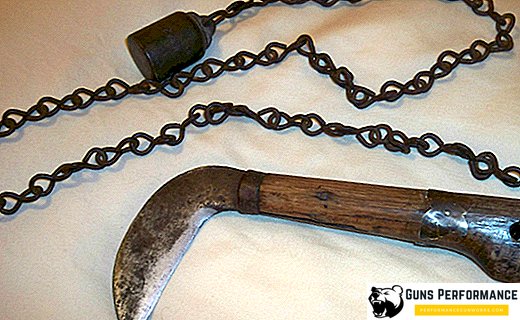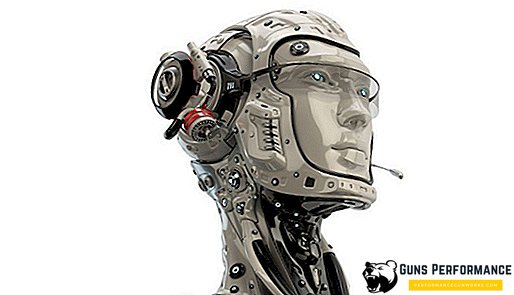
Man is a creature rather weak and vulnerable. Nature has given us neither the strength of a bear, nor the claws of a tiger, nor the venom of a viper. Our legs cannot be compared with a deer or a hare. But evolution has endowed man with an extremely developed brain, which turned out to be a far more effective tool in the struggle for survival than claws and fangs. People from time immemorial used their intellect to invent all kinds of murder weapons, often using the materials at hand.
A vivid example of human ingenuity in this area is Kusarigam, a type of Japanese melee weapon that appeared around the XIV century. It is not known to whom exactly the first to come to the head was a drawing of kusarigams, but already in the Muromachi period it became very widespread.
Even for exotic Japan, the country of mysterious ninja and samurai, the appearance of this weapon seems very unusual. Despite this, heavy kusarigam was an effective military weapon, which was used with great success by soldiers of the past.
This Japanese weapon consisted of a sickle (it was called Kama), the blade of which was perpendicular to the handle and had a special sharpening, as well as a shock load (fundo) attached to the sickle with a rope or chain (kusari). The handle of the sickle had a length of 50-60 cm, and its blade was about 20 cm. The chain was of considerable size, sometimes they reached 3.5 meters. She could be attached to the butt of the sickle, and to the opposite end of the handle.
There were a large number of varieties of kusarigam. They differed in the size of their elements, as well as their shape. Instead of the usual cargo, other “combat units” could hang on the end of the chain: tanks with explosives or flammable substances, balls, studded with sharp spikes, burning torches. If instead of the usual weight a tank with explosives was hung at the end of the chain, then in this case the weapon was called a bakukhatsu-gama or an explosive sickle.

Sometimes the load was wrapped in a rag soaked in incendiary composition. In battle, it was set on fire to further demoralize the enemy. We received information that sometimes a live poisonous viper was tied to the end of the chain, usually for this purpose they used a Japanese shtekomordnika. It is not known whether this is true or not, and how effective a weapon with such an outlandish striking element was, but it certainly brought wild terror to the enemies.
Kusarigama technique
One of the main advantages of kusarigama was its versatility. It can be said that this advantage compensated for the high complexity of using kusarigams. These weapons could be used to inflict cutting, stabbing, crushing blows to the enemy. The art of owning this fighting sickle is called kusarigamajutsu.
Sometimes a heavy kusarigam was used as a throwing weapon: a sickle can be thrown at the enemy, and in case of failure it can be returned with a chain. The sickle was effective in melee combat, and at long distances the enemy could be killed with the help of a kettlebell or entangled with a chain, and then finished off with a sickle. In the Japanese chronicles it is reported that kusarigam was often used as a throwing weapon in the defense of fortresses.

Kusarigama is considered one of the most complex types of Japanese melee weapons. In order to master it, the warrior needed thousands of hours of daily training. This factor seriously limited the spread of kusarigam.
Especially difficult was the method of wrapping the enemy's chain or his weapon. In order to perfectly master him, the fighter needed to perfectly develop his eye, to learn to feel subtly the moment when the enemy began to attack. Correct promotion of the chain was crucial for a successful throw, in case of an error, the fighter himself could become entangled in his own weapon. Another feature of Kusarigama was that in order to use the chain effectively, the fighter needed considerable free space.
There is a description of the epic duel between the skillful swordsman Araki Mataemon and Yamada Sinryukan, who skillfully owned kusarigama. Araki lured his adversary into a bamboo grove where Sinryukan could not fully use his deadly weapon.
As already mentioned above, it is not known who exactly invented the kusarigam, however, “agricultural” motives are clearly traced in this weapon. Often the merit of his invention is attributed to ninjas, which looks very plausible. After all, another undoubted advantage of kusarigam is the simplicity of its disguise. Having unhooked the load from the sickle, it is very easy to pass it off as ordinary agricultural equipment and get lost in a crowd of peaceful peasants. Yes, and to make such a weapon was easy.

Another fact that confirms the "espionage" origin of kusarigams is the time of the appearance of these weapons. The Muromachi or Sengoku period was also called the time of the Warring Provinces. There was complete confusion and chaos in the country, everyone fought with everyone, secret murders of military leaders were very often practiced. During this period, the ninja or shinobi had especially a lot of work. Unlike the sword, which is quite hard to hide, kusarigama is great for performing secret missions.
Although, samurai used kusarigama too. One of the most famous schools of possession of these weapons - Issin-ryu - was founded by a samurai named Nan Ami Jion. According to legend, this glorified warrior saw a deity in a dream with a sickle in one hand and a sinker in the other. Kusarigam, which is used in Issin-ryu, has an atypically long chain (more than 3.5 meters) and a sickle with double-edged sharpening.












